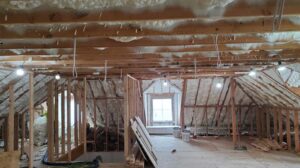Spray foam insulation has become a popular choice for homeowners looking to improve energy efficiency and reduce utility bills. Whether you’re insulating crawl spaces to combat moisture and cold, attics to maintain consistent temperatures, or basements for enhanced heat retention, this versatile solution offers significant benefits. But is spray foam insulation safe for your home environment?
With a few myths around this insulation type, it’s worth breaking down key health and safety details. When installed correctly, spray foam insulation can be a safe, effective solution for insulating your home, but it’s essential to understand the ins and outs to make the best decision.
That’s exactly what this article is here to help you with.
What Makes Spray Foam Insulation Safe When Properly Installed
Safety begins with professional installation. One crucial factor in keeping spray foam insulation safe is having it installed by trained professionals.
Professionals apply it in layers, ensuring it cures correctly, and preventing issues like trapped chemicals or incomplete hardening, which are the main points of concern.
Potential Health Risks During and Right After Installation
During installation, you’ll want to take some precautions to avoid exposure to the chemicals used in spray foam. Direct contact can cause temporary respiratory or skin irritation, so it’s best to keep a safe distance and avoid being in the area.
For extra protection, consider staying out of your home for a few hours post-installation, especially if you have respiratory sensitivities or allergies.
Ample ventilation also helps with any lingering odors or gases, so ensure you provide that, as well.
Long-Term Health Safety: What Happens After Curing
Once the foam cures, which typically takes just a few hours, it becomes stable and poses no threat to indoor air quality. Properly cured spray foam is considered chemically inert, meaning it doesn’t off-gas or release harmful emissions.
This makes it a dependable option for long-term home insulation, with minimal risk to your air quality.
Environmental and Structural Safety Benefits of Spray Foam
Spray foam insulation also contributes to a healthier home environment in ways beyond personal safety. Its superior sealing properties help block moisture, which reduces the risk of mold growth—a major factor in maintaining indoor air quality.
Spray foam also improves energy efficiency by keeping warm or cool air inside, leading to consistent, comfortable temperatures and lower energy bills.

Safety Precautions and Best Practices for Homeowners
Your role in safety doesn’t end with installation. To ensure the ongoing safety of spray foam insulation in your home, hire experienced contractors who follow industry standards.
Ensure your installer uses high-quality products and follows best practices, like proper ventilation and protective equipment during application. This diligence goes a long way in ensuring your insulation performs safely and efficiently.
Conclusion
So, is spray foam insulation safe? Yes, when you follow recommended guidelines and rely on professional installation, spray foam insulation can be a safe, effective solution that enhances your home’s energy efficiency.
By taking the necessary precautions during installation and choosing a trusted provider, you’ll enjoy the long-term benefits of this durable insulation material.
Ready to Insulate Your Home Safely?
If you’re looking to upgrade your home insulation safely and efficiently, our team at Spray Foam Insulation USA is here to help. Contact us today to discuss your insulation needs and make your home more comfortable and energy-efficient!





